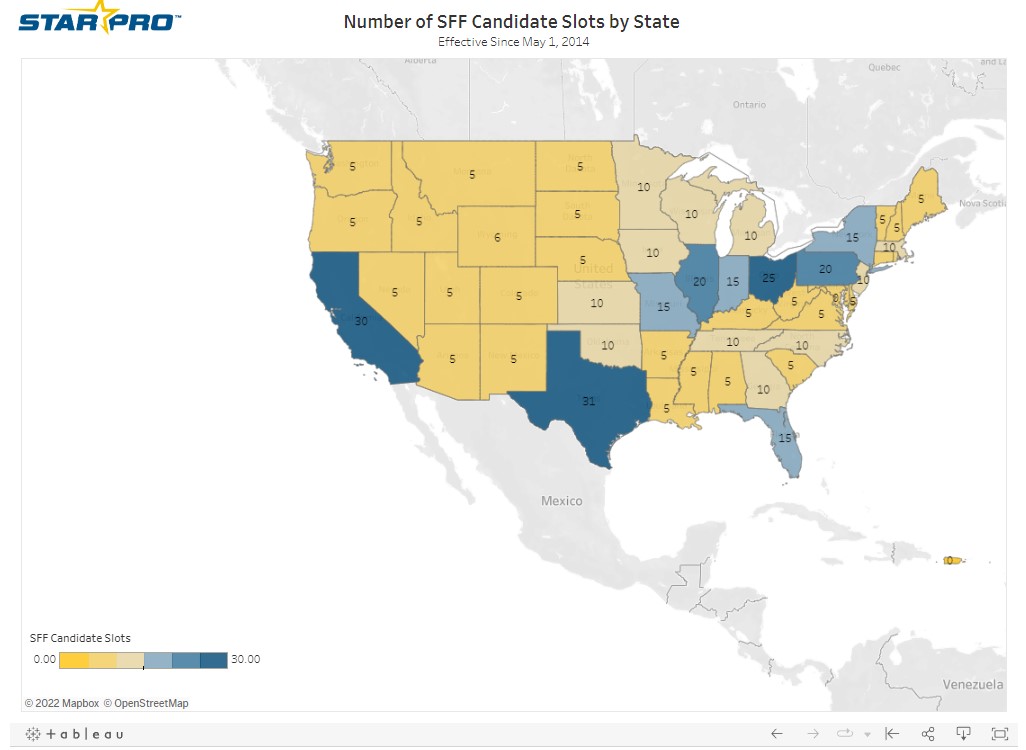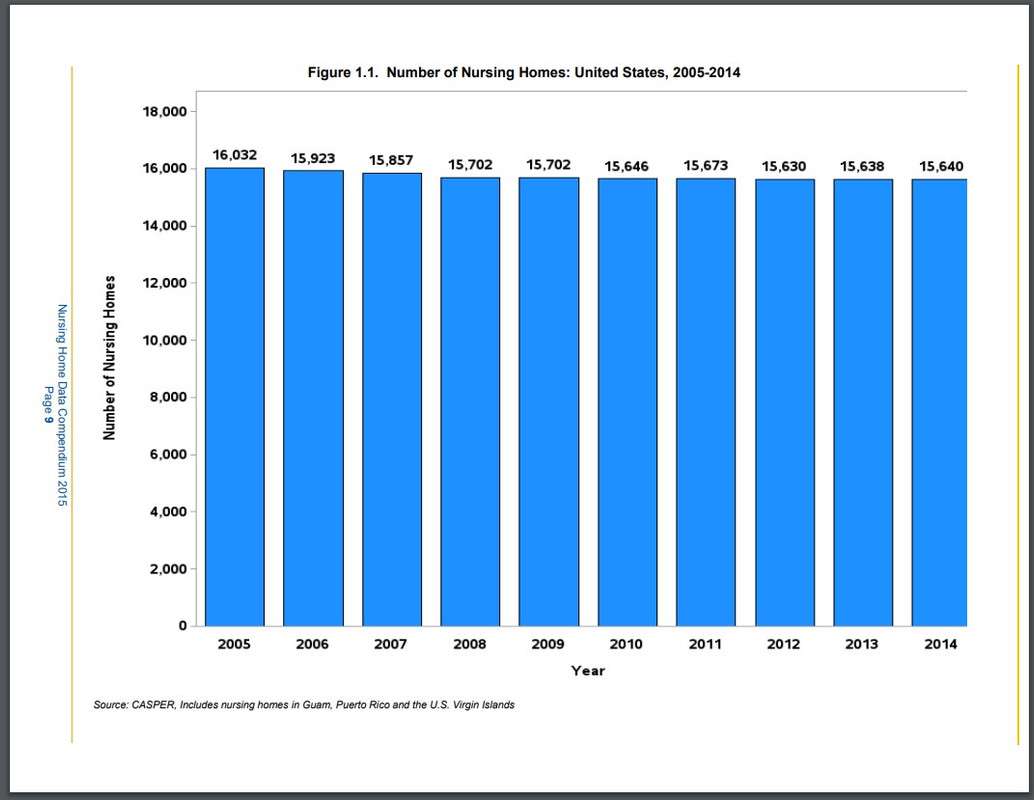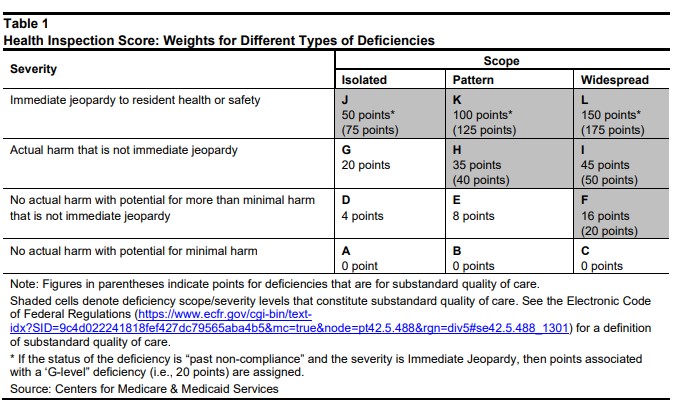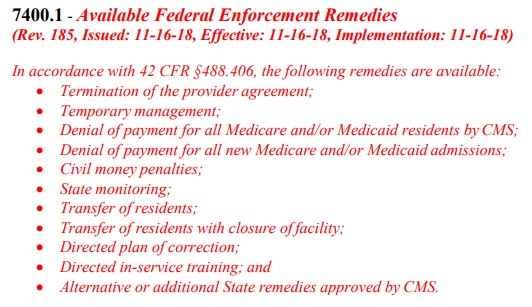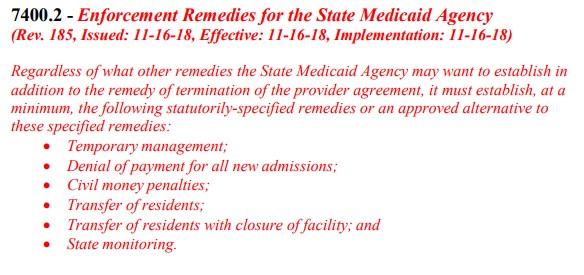Part
01
of one
Part
01
SFF Program Overview
Key Takeaways
- The SFF program has slots for 88 facilities, while the candidate list has more than 400 facilities on it.
- There are generally 5 candidate slots for each SFF opening. So to determine the number of SFFs that each state is allowed to have at any given time, divide the number of candidate slots by 5. Based on that methodology, the number of SFFs per state ranges from 1 (5/5) to 6 (30/5). The following table gives the exact number of SFF slots per state. It does not appear that these numbers have changed since at least 2014, although at one time there were 136 SFF slots.
- Based on the number of spots available on the candidate list, and the number of spots available in the SFF program, it is a very small number of facilities that receive either of those designations. According to the June 2022 data, 2.9% (441/15190*100) are on the candidate list, and 0.57% (86/15190*100) are designated SFF.
- Facilities are inspected approximately annually, and the score for determining whether a facility is a candidate for SFF is based on the three most recent inspections. Of note, more recent inspections are given more weight than older inspections, with the most recent inspection counting for 1/2 of the score, the previous year's inspection counting for 1/3, and the oldest inspection counting for 1/6. In cases where there is only one inspection available, no star rating is given, and, when only two inspections are available, the most recent is weighted at 60% while the older inspection counts 40%. (page 4)
- There is no indication that CMS provides any type of support to facilities that are designated as SFF. This can be seen from a thorough review of Chapter 7 of the State Operations Manual for CMS, which covers nursing homes. The SFF program instead focuses on enforcement remedies.
Introduction
Provided in this report on the Special Focus Facility (SFF) initiative are quantitative data on the program (number of facilities, number of candidates, failure rate, etc), details on how facilities are selected for the candidate list, details on how facilities are selected as an SFF, enforcement remedies utilized by the program, challenges being faced, limited data on long-term outcomes, and details on proposed legislation that would expand the program.
CMS only started publishing data on the nursing homes on the candidate list in 2019. Data on SFFs was also found to be limited in the public domain. Therefore, we were unable to provide lifetime numbers on how many SFFs there have been, how many facilities have been candidates, and the number of facilities that had their contracts terminated. In lieu of that data, we provided details on the total number of certified facilities, along with information on what portion of them are on the various SFF lists.
Overall, data on the program was sparse in the public domain, other than basics on the facilities currently on the lists, and details on how the program operates.
SFF Quantitative Data
- The SFF program was established by the Centers for Medicare & Medicaid Services (CMS) in 1998. However, the candidate list for the program was not publicly released until June 2019. At that time, CMS announced that the list would be updated monthly.
- Based on 2019 reporting, there were 400 nursing homes on the candidate list, and only 88 slots in the program. The following chart, which has been in effect since May 1, 2014, shows the total number of candidate slots by state.
- The most recent list of SFF candidates, published in June 2022, has about 440 candidates.
- There are generally 5 candidate slots for each SFF opening. So to determine the number of SFFs that each state is allowed to have at any given time, divide the number of candidate slots by 5. Based on that methodology, the number of SFFs per state ranges from 1 (5/5) to 6 (30/5). The following table gives the exact number of SFF slots per state. It does not appear that these numbers have changed since at least 2014, although at one time there were 136 SFF slots.
- It was not possible to determine the total number of nursing homes that were candidates for SFF over the course of the program, or the total number of nursing homes that have been in the program. The primary reason for this is that historical data for previous years is not available in the public domain. It appears that when new lists are published, the old lists are removed. In this report from 2010, a link to data from that year is provided, but it actually goes to the most recent 2022 data. This also happened with a link that purported to go to data from 2017.
- However, a 2017 article in the New York Times reported that from 2005 till the time of the article, over 900 facilities had been classified as SFF.
- Consolidated data on the number of nursing homes with terminated CMS contracts was not found to be available in the public domain. However, CMS does publish termination notices for facilities that are losing their Medicare termination. While the website states that termination notices will be available for 6 months, there are notices on the page as far back as 2019. There is no distinction made, at least in the titles of the termination notices, that would distinguish SFF facilities from non-SFF facilities.
- For 2022, we counted a total of about 40 notifications. However, some of these were rescinding previous terminations, and, without examining every facility individually, it is not possible to determine how many of them are nursing facilities. There appears to be a mixture of facility types included. Of course, data for one 6-month period is not sufficient to infer any generalities on the number of terminations.
- Recent reporting from Bloomberg indicated that about 10% of facilities with the SFF designation have their CMS contracts terminated.
Other Relevant Quantitative Data
- The most complete data found on the number of skilled nursing facilities certified by CMS was from the 2015 edition of the Nursing Home Data Compendium. This was the most recent compendium available on the CMS website.
- The compendium contains data from 2005 through 2014, and shows that while the number of CMS certified nursing facilities has declined since 2005, overall, the number of facilities have been relatively stable. From 2008 to 2014, the number of facilities only varied by 62 (15702-15640), while there were a total of 15,640 facilities in 2014. This means the total number of facilities only varied by 0.40% (62/15640*100) during that time.
- The most recent data on the number of nursing homes available on the CMS website is from June 23, 2022. One file within that folder was titled NH_ProviderInfo_Jun2022. That file was imported into a Google spreadsheet in order to examine the data. As a result, it was determined that as of the above date, there are 15,190 CMS certified nursing homes, which is a decrease from 2014.
- The spreadsheet was sorted by column S (Special Focus Status), and then by state, so all facilities with that designation were at the top of the list. The list shows 441 facilities that are SFF Candidates, and 86 that are in the SFF program.
- Based on the number of spots available on the candidate list, and the number of spots available in the SFF program, it is a very small number of facilities that receive either of those designations. According to the June 2022 data, 2.9% (441/15190*100) are on the candidate list, and 0.57% (86/15190*100) are designated SFF.
Qualitative Data
Criteria for Candidate List
- Candidates for SFF are determined using the same methodology that is used " in the health inspection domain of the Five-Star Quality Rating System." Under this system, higher scores mean worse performance. The following table shows how deficiencies discovered during inspections are scored based on the scope and severity of the problem.
- Facilities are inspected approximately annually, and the score for determining whether a facility is a candidate for SFF is based on the three most recent inspections. Of note, more recent inspections are given more weight than older inspections, with the most recent inspection counting for 1/2 of the score, the previous year's inspection counting for 1/3, and the oldest inspection counting for 1/6. In cases where there is only one inspection available, no star rating is given, and, when only two inspections are available, the most recent is weighted at 60% while the older inspection counts 40%. (page 4)
- In addition to annual inspections, the health inspection score is impacted by complaint inspections and focused infection control surveys from the previous 36 months, if they resulted in verifiable deficiencies.
- The facilities with the highest scores (most points) in each state are added to the candidate list. The number added to the list are limited to the total number allowed for each state based on the above chart.
Criteria for Entering Program
- Agencies in individual states are responsible for selecting the nursing homes to fill available SFF slots for individual states. The facilities chosen must be on the candidate list.
- Once a facility is chosen, the state must obtain approval from CMS. When an opening becomes available in a given state due to a previous facility graduating from the program or being terminated, the state agency has 21 days to select a replacement facility.
How SFF Supports Nursing Home Improvement
- There is no indication that CMS provides any type of support to facilities that are designated as SFF. This can be seen from a thorough review of Chapter 7 of the State Operations Manual for CMS, which covers nursing homes.
- The SFF program instead focuses on enforcement remedies, which are covered in the following section.
SFF Enforcement Remedies
- Once facilities have entered the SFF program, surveys and inspections occur at least twice a year, rather than the standard once a year. This is designed to encourage quick correction of problems, as facilities may be terminated from CMS after three bad reviews, which can happen within a 12-18 month period. However, in practice, it appears that facilities often stay in the program much longer than that.
- The federal enforcement remedies that are available for SFF facilities are:
- The state enforcement remedies that are available for SFF facilities are:
- The penalties are divided into three categories, and which remedy is chosen depends on the scope and severity of the violations. All violations have been taken directly from the manual.
- Category 1 remedies are a directed plan of correction, state monitoring, and directed in-service training
- Category 2 remedies are denial of payment for all new Medicare and/or Medicaid admissions; denial of payment for all Medicare and/or Medicaid residents, imposed only by the regional office; lower range per day civil money penalties; and per instance civil money penalties.
- Category 3 remedies are temporary management, termination, civil money penalties of $3,050 - $10,000 per day of noncompliance optional, in addition to the remedies of termination and/or temporary management; and civil money penalties of $1,000 - $10,000 per instance of noncompliance optional.
- A 2016 guidance letter indicated that remedies could be implemented immediately, and that regulators are not required to give facilities an opportunity to fix violations before penalties are imposed. This guidance additionally provided details on when remedies must be immediately imposed, and can't be waived at the discretion of the examiner.
SFF Challenges
- According to a fact sheet published by the White House in February 2022, one of the challenges facing the SFF initiative is a lack of funding for inspection activities. The funding for oversight has been flat for more than seven years, even as the number of complaints at nursing homes has increased. President Biden is asking Congress to provide close to a 25% increase in funding to CMS for health and safety inspections.
- Another challenge for nursing home oversight that is not unique to SFFs, but does impact the program, are so-called yo-yo facilities. These are facilities that are originally highlighted for improvement, do just enough to get better, but then return to old practices. This happens with SFFs, as can be seen by the large number that have significant violations after they have been removed from the SFF program.
- Finally, at any given time there is a large waiting list for nursing homes that are eligible for additional oversight. Since the program states that there have to be five facilities on the candidate list for every available slot, this means that there are at least five times as many problematic nursing homes as slots. While the homes do not want to find themselves in the SFF program, the serious quality issues identified indicate that additional oversight is needed to protect patients.
- Mark Parkinson, the president and CEO of the American Health Care Association, believes that the SFF program should include the bottom 10% of nursing homes, and that the focus should be on providing help, rather than penalties. "What they don’t need is more fines and regulations. They need someone to come in and help them.”
Reports on Program Outcomes
- A New York Times article from 2017 found that of "528 nursing homes that graduated from special focus status before 2014 and are still operating, slightly more than half — 52 percent — have since harmed patients or put patients in serious jeopardy within the past three years."
- A special report from the Center for Medicare Advocacy in 2019, found that "more than one-third of the facilities received the lowest federal rating for health and safety," after graduating from the SFF program. The study also looked at that quality of care prior to the facilities graduating, and noted that there were many serious deficiencies which did not appear to keep the facilities from graduating from the program.
Nursing Home Reform Modernization Act of 2021
- On March 17, 2021, the Nursing Home Reform Modernization Act was introduced in the House of Representatives and in the Senate. The bill has bipartisan sponsors.
- The legislation wants to expand the number of spots available in the SFF program so that all facilities on the candidate list would receive enhanced oversight and enforcement.
- However, an important part of the proposed legislation is to provide both technical support and educational programming to SFFs. As mentioned above, there is no indication that SFFs are currently provided with any support.
- It does not appear that any further action has been taken in either the House or Senate on the bills.
Research Strategy
For this research on SFFs, we leveraged the most reputable sources of information that were available in the public domain, including CMS, GAO, New York Times, and Bloomberg.
